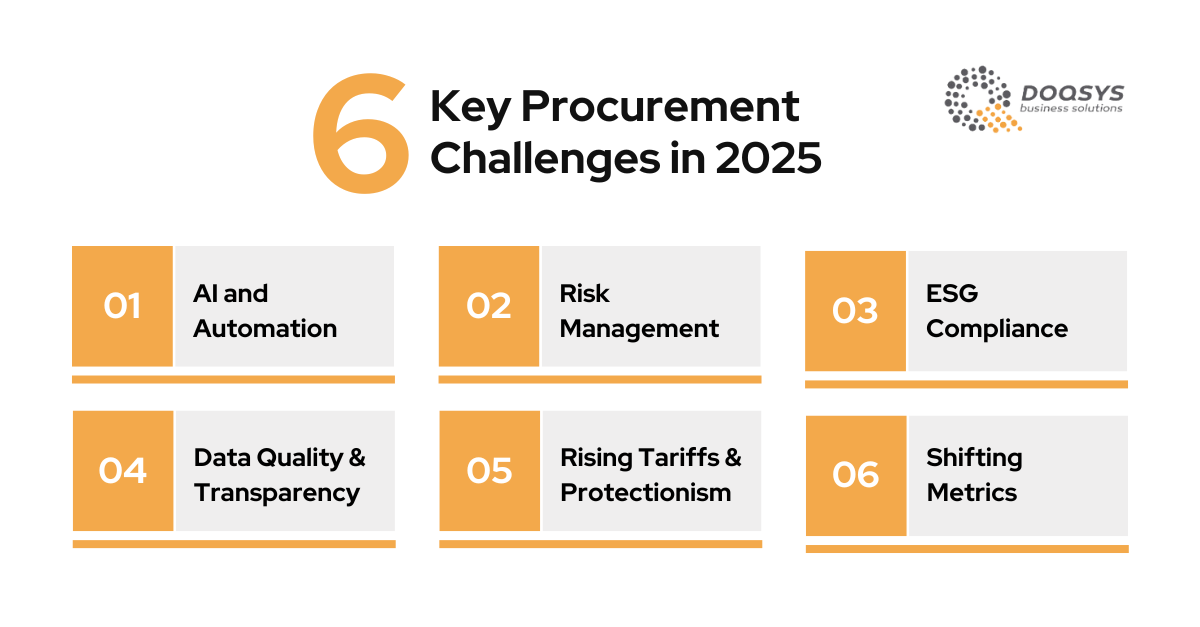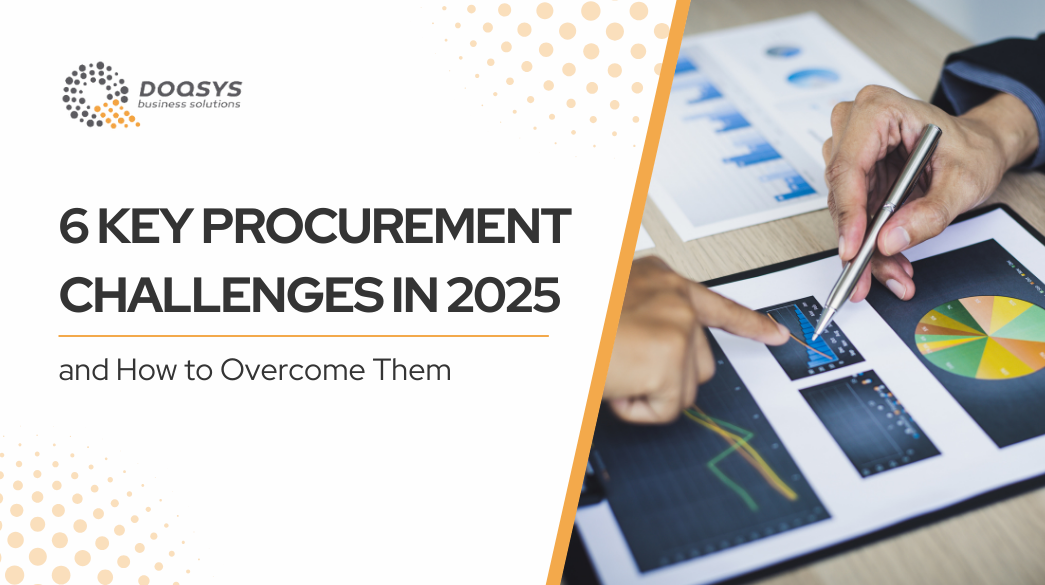The procurement landscape is evolving rapidly, shaped by geopolitical turbulence, sustainability mandates, and AI-driven technologies. As we approach 2025, procurement teams face growing pressures to drive strategic value, ensure compliance, and mitigate risk in increasingly complex supply chains.
In this post, we’ll explore the top procurement challenges in 2025 – based on GEP’s outlook on key trends, challenges, and opportunities within procurement – and actionable strategies to address them; which can potentially enable procurement professionals to stay ahead of disruption and deliver measurable value.

1. AI and Automation: Opportunity or Overload?
Artificial intelligence (AI) is no longer a futuristic buzzword. In 2025, autonomous AI agents will redefine procurement operations by automating sourcing, risk analysis, and supplier management. AI-driven tools can analyze unstructured data, predict demand, and optimize supply chains in real-time – freeing procurement professionals to focus on strategic decision-making.
However, the rapid adoption of AI comes with challenges. Data overload, system integration, and governance will become pain points as organizations race to implement AI tools. Without structured data or scalable systems, even the most advanced AI platforms will fail to deliver results.
Solution: Start small by piloting AI tools in high-impact areas, such as demand forecasting or supplier risk monitoring. Invest in strong data governance frameworks to ensure AI systems receive accurate, actionable data. Partner with trusted providers to scale AI adoption efficiently.
2. Risk Management: A “Just-in-Case” World
Post-pandemic procurement strategies have shifted from “just-in-time” to “just-in-case.” Market volatility, trade restrictions, and extreme weather events continue to disrupt global supply chains, leaving organizations vulnerable to rising costs and shortages.
Beyond external risks, internal challenges – like siloed data, inefficient workflows, and fraudulent activities – add further complexity. Leadership teams now expect procurement to proactively manage risks and ensure supply chain resilience.
Solution: Adopt real-time risk monitoring tools that assess supplier health, geopolitical threats, and market fluctuations. Develop flexible sourcing strategies like nearshoring or friendshoring to diversify supply networks. Regularly audit suppliers and integrate ESG risk assessments into procurement processes.
3. ESG Compliance and Scope 3 Emissions
Sustainability isn’t optional anymore; it’s a competitive necessity. Growing regulatory pressure – particularly around Scope 3 emissions and ethical sourcing – requires organizations to track and minimize their environmental impact. In Europe, strict ESG standards demand businesses prove their supply chains are carbon-efficient and socially responsible.
However, ensuring compliance across a vast supplier network is no small feat. Poor visibility into supplier activities can lead to unintended violations, reputational damage, and costly fines.
Solution: Implement supplier transparency tools that monitor emissions, working conditions, and ethical practices. Use AI and automation to streamline sustainability reporting and compliance checks. Establish KPIs for supplier diversity, carbon reduction, and fair labor practices to ensure alignment with ESG goals.
4. Data Quality and Transparency
The foundation of effective procurement lies in reliable, high-quality data. Yet many organizations still struggle with fragmented systems, outdated data, and manual reporting processes. These issues lead to poor decision-making, missed cost-saving opportunities, and inefficient supplier management.
Generative AI further complicates the problem. While the technology offers immense potential, it risks amplifying inaccuracies if applied to low-quality or disorganized data.
Solution: Invest in data analytics tools to centralize and cleanse procurement data. Prioritize data governance to ensure consistency across systems. By leveraging AI-powered analytics, procurement teams can gain actionable insights into supplier performance, spending patterns, and potential risks.
5. Rising Tariffs and Protectionism
Global trade dynamics are shifting, with tariffs, trade barriers, and protectionist policies driving up procurement costs. These trends are encouraging organizations to reconsider their sourcing strategies, balancing cost efficiency with resilience.
For instance, businesses are increasingly embracing nearshoring to reduce reliance on distant suppliers while mitigating geopolitical risks. However, this shift requires recalibrating total cost of ownership (TCO) metrics to account for regional variations and sustainability goals.
Solution: Reassess TCO to include geopolitical, environmental, and logistical risks. Develop regional supply chain hubs to improve flexibility and reduce transportation emissions. Stay agile by building partnerships with local and “friendly” suppliers in key markets.
6. Shifting Metrics for Procurement Success
Cost savings remain a cornerstone of procurement, but success metrics are expanding. Organizations now measure procurement value through resilience, sustainability, and compliance alongside cost efficiency. Procurement leaders must effectively communicate this broader value to stakeholders.
Solution: Develop and communicate KPIs for flexibility, carbon footprint, and supplier diversity. Use dashboards and reporting tools to showcase procurement’s strategic contributions – whether it’s improving supply chain resilience, enhancing ESG compliance, or driving digital transformation.
Closing Thoughts
Procurement in 2025 will be anything but business as usual. AI advancements, regulatory demands, and volatile markets will push procurement teams to adapt and innovate. By embracing technology, prioritizing sustainability, and fostering collaboration, businesses can turn these challenges into opportunities for growth and resilience.
The shift from cost control to strategic value creation means procurement will play a central role in driving business success. Leveraging tools like AI-powered analytics and platforms such as SAP Ariba, organizations can optimize supplier relationships, streamline processes, and improve decision-making.
Transparency, agility, and sustainability will define the leaders of tomorrow. Those who invest in future-ready solutions and rethink traditional procurement practices will not only weather the challenges ahead but emerge stronger and more competitive.
With DOQSYS as your trusted partner, businesses can confidently navigate this new era of procurement. From optimizing processes to implementing cutting-edge solutions, we’re here to ensure your procurement strategy drives measurable success and long-term resilience.
How DOQSYS Helps You Overcome Procurement Challenges
Navigating these challenges requires more than just tools – it demands expertise, strategic vision, and the right technology partner. At DOQSYS Business Solutions, we’re here to help. As an ADVANCED SAP Ariba implementation partner, we support organizations end-to-end – from designing tailored procurement solutions to seamless implementation and post-go-live hypercare.
Our procurement experts specialize in optimizing source-to-pay processes through SAP Ariba, ensuring enhanced efficiency, cost control, and compliance for your business. Whether you’re tackling supply chain risk, ESG reporting, or digital transformation, DOQSYS helps you turn challenges into opportunities.
Ready to future-proof your procurement strategy? Reach out to our team and discover how we can transform your procurement processes for 2025 and beyond.
